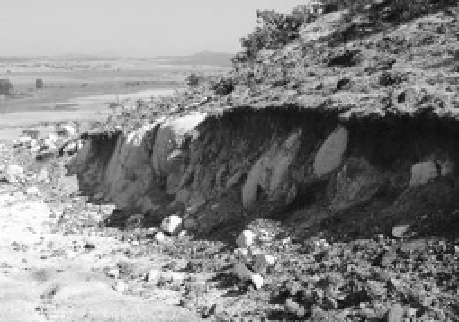Environmental Engineering Reference
In-Depth Information
They constitute the substratum of a dominant
proportion of the dam foundation. They tend
to produce gentle slopes and, in the lower culti-
vated plots they are covered by alluvial clays. The
exposed tuff is not cultivated probably due to the
high soil acidity.
When exposed in cuts the tuff appears as a soft
massive rock. Unconfined compression strength,
determined in cores lie in the range 1-10 MPa. in
general the sPT sampler does not penetrate in the
tuff. exposed contacts between tuff and basaltic
flows are apparently tight. no open cracks or dis-
continuities have been observed. Recovered cores
provide also information on the nature of contacts.
a review of the cores in transitions indicated also a
Tuff is exposed in some locations by inter-
mittent creeks which erode the surface mantle
Figure 4.
erosion patterns of tuff by running water.
Figure 5.
Remoulded tuff.
of colluvial soils. The exposed tuff is eroded by
running waters and it shows erosion patterns simi-
ing erosion forms tend to be rounded. however no
firm evidence of piping was observed.
The tuff has a low unit weight but it is very hetero-
geneous. Unit weights in the range 18.3-15.5 kn/m
3
have been reported. Porosity is difficult to determine
because no reliable indication of the tuff minerals is
available and, therefore, the solid unit weight is not
available. When wetted it displays a soft, clay like,
slippery touch, a consequence of the present miner-
Figure 2. exposed volcanic tuff covered by a thin man-
tle of residual soils. in the background a cultivated valley
(alluvial soils).
2
inTacT TUFF Rock TesTs on coRes
2.1
Background
Tests were performed on core pieces recovered in
borings. cores were kept in dry conditions, “in situ”,
exposed to the atmosphere and later transported
to the laboratory. some of the determinations
were performed also under “dry” conditions at
the Rh prevailing at the laboratory in Barcelona
Figure 3.
Tight transition between tuff and basalt.



















